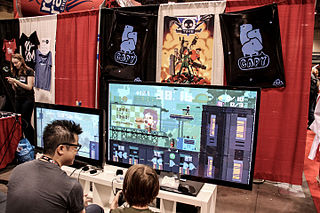
A video game is an electronic game that involves interaction with a user interface or input device to generate visual feedback from a display device, most commonly shown in a video format on a television set, computer monitor, flat-panel display or touchscreen on handheld devices, or a virtual reality headset. Most modern video games are audiovisual, with audio complement delivered through speakers or headphones, and sometimes also with other types of sensory feedback, and some video games also allow microphone and webcam inputs for in-game chatting and livestreaming.

E3 is a trade event for the video game industry in the United States. The Entertainment Software Association (ESA) organizes and presents E3, which many developers, publishers, hardware, and accessory manufacturers use to introduce and advertise upcoming games and game-related merchandise to retailers and to members of the press. E3 includes an exhibition floor for developers, publishers, and manufacturers to showcase their titles and products for sale in the upcoming year. Before and during the event, publishers and hardware manufacturers usually hold press conferences to announce new games and products.

The video game industry is the tertiary and quaternary sectors of the entertainment industry that specialize in the development, marketing, distribution, monetization and consumer feedback of video games. The industry encompasses dozens of job disciplines and thousands of jobs worldwide.
The Academy of Interactive Arts & Sciences (AIAS) is a non-profit organization of video game industry professionals. It organizes the annual Design Innovate Communicate Entertain summit, better known as D.I.C.E., which includes the presentations of the D.I.C.E. Awards.

The Game Developers Conference (GDC) is an annual conference for video game developers. The event includes an expo, networking events, and awards shows like the Game Developers Choice Awards and Independent Games Festival, and a variety of tutorials, lectures, and roundtables by industry professionals on game-related topics covering programming, design, audio, production, business and management, and visual arts.

Pixel art is a form of digital art drawn with graphical software where images are built using pixels as the only building block. It is widely associated with the low-resolution graphics from 8-bit and 16-bit era computers and arcade video game consoles, in addition to other limited systems such as LED displays and graphing calculators, which have a limited number of pixels and colors available. The art form is still employed to this day by pixel artists and game studios, even though the technological limitations have since been surpassed.
2003 saw many sequels and prequels in video games, such as Tony Hawk's Underground, Final Fantasy X-2, Mario Kart: Double Dash, Mario & Luigi: Superstar Saga, Prince of Persia: The Sands of Time, Sonic Heroes, Star Wars: Knights of the Old Republic, and WWE SmackDown! Here Comes the Pain. New intellectual properties included Beyond Good & Evil, Boktai: The Sun is in Your Hand, Call of Duty, Disgaea, Drakengard, Manhunt, PlanetSide, TrackMania, True Crime: Streets of LA, and Viewtiful Joe.

The Entertainment Software Association (ESA) is the trade association of the video game industry in the United States. It was formed in April 1994 as the Interactive Digital Software Association (IDSA) and renamed on July 21, 2003. It is based in Washington, D.C. Most of the top publishers in the gaming world are members of the ESA, including Capcom, Electronic Arts, Konami, Microsoft, Bandai Namco Entertainment, Nintendo, Sony Interactive Entertainment, Square Enix, Take-Two Interactive, Ubisoft, and Warner Bros. Interactive Entertainment.

The Los Angeles Convention Center is a convention center in the southwest section of downtown Los Angeles. It hosts multiple annual conventions and has often been used as a filming location in TV shows and movies.

GamePolitics.com was a blog which covered the politics of computer and video games. GamePolitics was launched by freelance journalist Dennis McCauley in March 2005. At the time, McCauley was the video game columnist for The Philadelphia Inquirer, a position he held from 1998 to 2009. Growing somewhat bored of writing video game reviews, McCauley created GamePolitics in order to track the political, legal and cultural impact of video games. The site was often referred to as GP by followers.

Brian L. Schmidt is a music composer for various video games and pinball machines.
The concept of video games as a form of art is a commonly debated topic within the entertainment industry. Though video games have been afforded legal protection as creative works by the Supreme Court of the United States, the philosophical proposition that video games are works of art remains in question, even when considering the contribution of expressive elements such as acting, visuals, stories, interaction and music. Even art games, games purposely designed to be a work of creative expression, have been challenged as works of art by some critics.

Entertainment for All Expo or E for All was a public video game trade show, created to allow the general public to see and experience new products from the video game industry. The inaugural E for All Expo was open October 18 to October 21, 2007, at the Los Angeles Convention Center. The Second E For All Convention took place from October 3 through October 5, 2008 at the Los Angeles Convention Center.
The Montreal International Games Summit (MIGS), also known as Le Sommet International du jeu de Montréal (SIJM), is a conference on video games. The first summit was held in 2004 and usually takes place in November at Le Palais des Congrès de Montreal. Its mission is to expand the exposure of the video game community in Quebec, and to improve the Quebec video game industry. MIGS is currently the leading professional gaming summit of the East Coast. The overall aim of MIGS is to promote, train, network, and hire potential developers in the gaming industry. Professionals attending the summit partake in lectures and presentations largely oriented around how to improve specific aspects of the industry, such as art, VFX, and design. Currently, MIGS has partnered with many of the leading electronic and game development companies in Canada, including Ubisoft and Warner Bros. Games. The Montreal International Gaming Summit is networked similarly to the Electronic Entertainment Expo, using the same application to facilitate interaction between industry players and the associates. In 2008 MIGS became an event that was open to the public. 2013 marked the tenth annual Montreal International Gaming Summit.

Christopher Robert Melissinos is a leading figure in the Java programming language community. He served as Sun Microsystems' Chief Evangelist and Chief Gaming Officer. During his tenure at Sun, he was responsible for the creation of their Game Technologies Group and was a driving political force behind the formation of several open source Java gaming technologies including Project Darkstar, and Java bindings for OpenGL, OpenAL and Jinput.

Game Design Expo is an annual event in Vancouver, British Columbia, Canada for video game industry professionals and enthusiasts, hosted by Vancouver Film School's Game Design program. The inaugural event in 2007 was the first of its kind in Vancouver. Game Design Expo has presented such industry speakers as Ron Gilbert and Eric Zimmerman, and designers and producers from companies like Bungie, Activision, Electronic Arts, BioWare, and Mythic Entertainment.

Canada's video game industry consists of approximately 32,300 employees across 937 companies. In 2021, the industry generated an estimated US$ 3.4 billion in revenue, having grown by 20% since 2019. Video game development is beginning to rival the film and television production industry as a major contributor to the Canadian economy.
CIIT Philippines - College of Arts and Technology is a private, non-sectarian educational institution in the Philippines that at provides specialized and practical education with a focus on arts, technology, and business.

The Electronic Entertainment Expo 2016 was the 22nd E3, during which several hardware manufacturers and software developers and publishers from the video game industry presented new and upcoming products to the attendees, primarily retailers and members of the video game press. The event, organized by the Entertainment Software Association, took place at the Los Angeles Convention Center from June 14–16, 2016. Approximately 50,300 people attended the event, slightly down from the previous year's. With video game consoles currently a couple years into their 8th generation, the focus of E3 2016 was primarily on new software titles, with new hardware revisions and auxiliary equipment to support the growing market sectors of 4K resolution displays and virtual reality headsets.

Flinthook is platform game roguelike by Tribute Games in which the player's character uses a grappling hook to traverse procedurally generated spaceships for treasure. The developers were inspired by "rogue-lites" including Spelunky and Rogue Legacy. They said that the grappling hook game mechanic was their hardest design challenge. The game was released in April 2017 for Windows, macOS, Linux, PlayStation 4, and Xbox One, followed by a release for Nintendo Switch in March 2018. Early previews of Flinthook noted the accessibility and tightness of the controls. Digital Trends and Kotaku listed the game among the best in show at the June 2016 Electronic Entertainment Expo.













